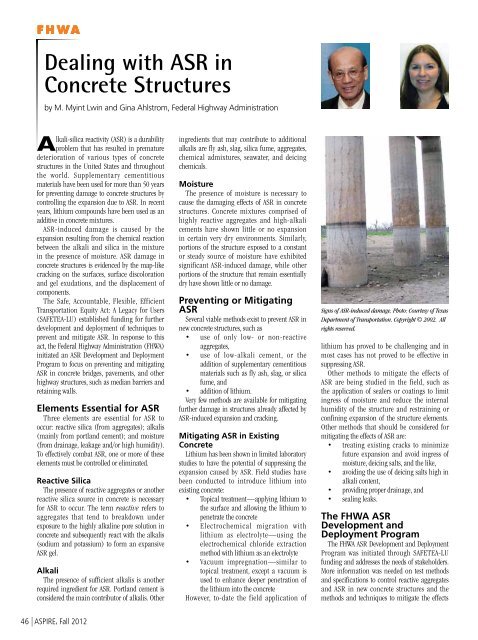ASPIRE Fall 2012 - Aspire - The Concrete Bridge Magazine
ASPIRE Fall 2012 - Aspire - The Concrete Bridge Magazine
ASPIRE Fall 2012 - Aspire - The Concrete Bridge Magazine
You also want an ePaper? Increase the reach of your titles
YUMPU automatically turns print PDFs into web optimized ePapers that Google loves.
FHWA<br />
Dealing with ASR in<br />
<strong>Concrete</strong> Structures<br />
by M. Myint Lwin and Gina Ahlstrom, Federal Highway Administration<br />
Alkali-silica reactivity (ASR) is a durability<br />
problem that has resulted in premature<br />
deterioration of various types of concrete<br />
structures in the United States and throughout<br />
the world. Supplementary cementitious<br />
materials have been used for more than 50 years<br />
for preventing damage to concrete structures by<br />
controlling the expansion due to ASR. In recent<br />
years, lithium compounds have been used as an<br />
additive in concrete mixtures.<br />
ASR-induced damage is caused by the<br />
expansion resulting from the chemical reaction<br />
between the alkali and silica in the mixture<br />
in the presence of moisture. ASR damage in<br />
concrete structures is evidenced by the map-like<br />
cracking on the surfaces, surface discoloration<br />
and gel exudations, and the displacement of<br />
components.<br />
<strong>The</strong> Safe, Accountable, Flexible, Efficient<br />
Transportation Equity Act: A Legacy for Users<br />
(SAFETEA-LU) established funding for further<br />
development and deployment of techniques to<br />
prevent and mitigate ASR. In response to this<br />
act, the Federal Highway Administration (FHWA)<br />
initiated an ASR Development and Deployment<br />
Program to focus on preventing and mitigating<br />
ASR in concrete bridges, pavements, and other<br />
highway structures, such as median barriers and<br />
retaining walls.<br />
Elements Essential for ASR<br />
Three elements are essential for ASR to<br />
occur: reactive silica (from aggregates); alkalis<br />
(mainly from portland cement); and moisture<br />
(from drainage, leakage and/or high humidity).<br />
To effectively combat ASR, one or more of these<br />
elements must be controlled or eliminated.<br />
Reactive Silica<br />
<strong>The</strong> presence of reactive aggregates or another<br />
reactive silica source in concrete is necessary<br />
for ASR to occur. <strong>The</strong> term reactive refers to<br />
aggregates that tend to breakdown under<br />
exposure to the highly alkaline pore solution in<br />
concrete and subsequently react with the alkalis<br />
(sodium and potassium) to form an expansive<br />
ASR gel.<br />
Alkali<br />
<strong>The</strong> presence of sufficient alkalis is another<br />
required ingredient for ASR. Portland cement is<br />
considered the main contributor of alkalis. Other<br />
ingredients that may contribute to additional<br />
alkalis are fly ash, slag, silica fume, aggregates,<br />
chemical admixtures, seawater, and deicing<br />
chemicals.<br />
Moisture<br />
<strong>The</strong> presence of moisture is necessary to<br />
cause the damaging effects of ASR in concrete<br />
structures. <strong>Concrete</strong> mixtures comprised of<br />
highly reactive aggregates and high-alkali<br />
cements have shown little or no expansion<br />
in certain very dry environments. Similarly,<br />
portions of the structure exposed to a constant<br />
or steady source of moisture have exhibited<br />
significant ASR-induced damage, while other<br />
portions of the structure that remain essentially<br />
dry have shown little or no damage.<br />
Preventing or Mitigating<br />
ASR<br />
Several viable methods exist to prevent ASR in<br />
new concrete structures, such as<br />
• use of only low- or non-reactive<br />
aggregates,<br />
• use of low-alkali cement, or the<br />
addition of supplementary cementitious<br />
materials such as fly ash, slag, or silica<br />
fume, and<br />
• addition of lithium.<br />
Very few methods are available for mitigating<br />
further damage in structures already affected by<br />
ASR-induced expansion and cracking.<br />
Mitigating ASR in Existing<br />
<strong>Concrete</strong><br />
Lithium has been shown in limited laboratory<br />
studies to have the potential of suppressing the<br />
expansion caused by ASR. Field studies have<br />
been conducted to introduce lithium into<br />
existing concrete:<br />
• Topical treatment—applying lithium to<br />
the surface and allowing the lithium to<br />
penetrate the concrete<br />
• Electrochemical migration with<br />
lithium as electrolyte—using the<br />
electrochemical chloride extraction<br />
method with lithium as an electrolyte<br />
• Vacuum impregnation—similar to<br />
topical treatment, except a vacuum is<br />
used to enhance deeper penetration of<br />
the lithium into the concrete<br />
However, to-date the field application of<br />
Signs of ASR-induced damage. Photo: Courtesy of Texas<br />
Department of Transportation. Copyright © 2002. All<br />
rights reserved.<br />
lithium has proved to be challenging and in<br />
most cases has not proved to be effective in<br />
suppressing ASR.<br />
Other methods to mitigate the effects of<br />
ASR are being studied in the field, such as<br />
the application of sealers or coatings to limit<br />
ingress of moisture and reduce the internal<br />
humidity of the structure and restraining or<br />
confining expansion of the structure elements.<br />
Other methods that should be considered for<br />
mitigating the effects of ASR are:<br />
• treating existing cracks to minimize<br />
future expansion and avoid ingress of<br />
moisture, deicing salts, and the like,<br />
• avoiding the use of deicing salts high in<br />
alkali content,<br />
• providing proper drainage, and<br />
• sealing leaks.<br />
<strong>The</strong> FHWA ASR<br />
Development and<br />
Deployment Program<br />
<strong>The</strong> FHWA ASR Development and Deployment<br />
Program was initiated through SAFETEA-LU<br />
funding and addresses the needs of stakeholders.<br />
More information was needed on test methods<br />
and specifications to control reactive aggregates<br />
and ASR in new concrete structures and the<br />
methods and techniques to mitigate the effects<br />
46 | <strong>ASPIRE</strong>, <strong>Fall</strong> <strong>2012</strong>

















